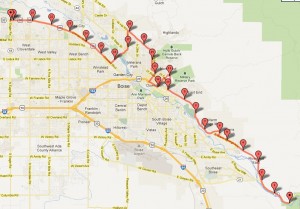Today, I want you to think about how the readings about place this week might inform or influence your upcoming assignments for this class: the grant proposal, the Boise Wiki article (undergraduates only), and the augmented reality project.
Some questions to consider:
1. Following Lewis’s example of the monument and bungalows, do you anticipate highlighting any tensions in the places you are interpreting? If so, how will you use those tensions in making your arguments about a place?
2. Which of Henderson’s “four dominant discourses on landscape”—landscape as landschaft, landscape as social space, the epistemological landscape, and the apocryphal landscape—will inform your projects?
3. Will the historical interpretation in your projects lean more in the positive or normative direction?
4. Hillier’s chapter on redlining in Philadelphia describes patterns of lending to home buyers and concludes that mid-twentieth-century redlining “is a more complicated process than many historians have appreciated” rather than a story of racial discrimination (88). Still, her essay has relevance to home-buying and mortgage-lending issues today. Will social justice, or at least informing ongoing policy discussions, be a guiding principle or goal of your project?
5. Beveridge’s essay on immigration, ethnicity, and race in New York highlights how GIS showed that although metropolitan New York is growing more culturally and racially diverse, it is also more segregated than ever. If you’re proposing to use GIS in your grant proposal, what concepts or phenomena do you hope it will similarly clarify?
6. Cunfer’s piece on the Dust Bowl contests the common conception that human activities were the primary cause of dust storms in the 1930s. Do you expect your project to disabuse historians and others of common misconceptions? If so, how will you make your case sufficiently strong to change people’s minds about what they think they know?
7. Fiege argues that historians and others studying the western U.S. must consider the intersection of private property and nature, both in terms of their physical presence (e.g., fences, cultivated fields, water, wildlife) and cultural beliefs (e.g. sanctity of private property, ideas about wildlife management). How might a consideration of the ecological commons influence your project’s interpretation of a place or phenomenon?
8. Cunfer’s and Pearson and Collier’s chapters in Past Time, Past Place and Fiege’s chapter in Everyday America draw on both environmental and cultural data and history. Would such a synthesis benefit your project? Why or why not? What kinds of data and evidence are you going to use, and how are you planning to synthesize them into a coherent project?
9. Sewell shows how, despite attempts to create separately gendered spaces (offices and department stores, for example), the reality of gendered interaction in downtown San Francisco, especially at street level, was more complicated. How is your ongoing work on your project balancing the analysis of geographical or architectural space with research into the actual historical interaction among people in that space?
10. Rojas takes an environment that is familiar to him—the streets and yards of East Los Angeles—and makes them comprehensible to readers who might find the spaces and interactions foreign or even (at first glance) undesirable. How does your project make comprehensible and interesting a concept, phenomenon, or place people might find unfamiliar, uninteresting, or even strange?
